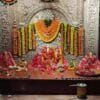Summary
Kalyani Devi Temple in Prayagraj, a significant Shakti Peetha, marks where three fingers of Sati fell. Worshipped as a form of Durga, the temple houses three deities. While the current structure dates to 1883 AD, the idols are believed to be much older. It’s a key pilgrimage site, especially during Navratri.
Location
- Khushal parvat, Attarsuiya, Kalyani Devi, Prayagraj, Uttar Pradesh 211003
Full Story
Shri Kalyani Devi Temple in Prayagraj is a significant Shakti Peetha, deeply rooted in Hindu mythology and ancient traditions. Here’s a detailed look at its history:
Mythological Origins (Shakti Peetha):
- Sati’s Body Parts: Like other Shakti Peethas, Kalyani Devi Temple is associated with the legend of Sati, Lord Shiva’s consort. According to the myth, when Sati immolated herself at her father Daksha’s yagna (ritual sacrifice), a grief-stricken Shiva carried her body across the universe. To pacify his grief and prevent cosmic imbalance, Lord Vishnu used his Sudarshan Chakra to dismember Sati’s body. The places where these body parts fell became sacred Shakti Peethas.
- Three Fingers: It is believed that three fingers of Goddess Sati fell at the location of the Kalyani Devi Temple, making it a particularly important Shakti Peetha.
The Deity: Kalyani Devi:
- Form of Durga: Kalyani Devi is considered a form of Durga, the warrior goddess and a powerful manifestation of Shakti (divine feminine energy).
- Three Deities: Within the temple, the goddess is worshipped in three forms, representing the three fingers that fell there:
- Kalyani Devi (center): The main deity.
- Shankar-Parvati (right): Representing Shiva and Parvati.
- Chinnamasta Devi (left): One of the ten Mahavidyas, representing self-sacrifice and spiritual awakening.
Historical Accounts and Temple Structure:
- Ancient Origins: While the current temple structure might be more recent, the site’s sanctity dates back much further. Ancient texts and manuscripts mention this Shakti Peetha, indicating its long-standing importance.
- Temple Construction (1883 AD): Many sources state that the current temple structure was constructed in 1883 AD. However, it’s important to note that the idols of the goddess are believed to be much older, possibly around 1500 years old.
- Sage Yagyavalkya: Some accounts mention that the sage Yagyavalkya performed deep meditation at this place during the Treta Yuga (a distant epoch in Hindu cosmology) and installed the 32-inch idol of Kalyani Devi.
Significance and Practices:
- Powerful Shakti Peetha: As a Shakti Peetha, the temple is considered a powerful source of divine energy and a place where devotees can receive blessings and fulfill their wishes.
- Pilgrimage Site: It attracts pilgrims from all over India, especially during Navratri, when special pujas and celebrations are held.
- Part of Prayagraj’s Shakti Peetha Circuit: Along with Lalita Devi and Alopi Devi temples, Kalyani Devi Temple completes a significant triad of Shakti Peethas in Prayagraj, making the city a very important center for Shakti worship.
In summary, Kalyani Devi Temple is a highly revered Shakti Peetha with ancient origins, a strong mythological background related to Sati, and a history of devotion spanning many centuries. It continues to be an important pilgrimage site for devotees seeking the blessings of the Divine Mother.




















Reviews
There are no reviews yet.